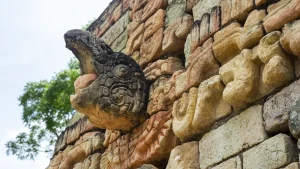The Chortís, direct descendants of the Mayans – The Mayan Civilization
Return to the main article The Maya Civilization
It is common while in Copán Ruinas, to observe the presence of a good amount of Chortís (in their language it means: “milperos mouth”), coming from nearby villages such as El Carrizal, Catedral, El Encantadito and El Quebracho, among others, that they go down to Copán Ruinas to exchange products.
This living culture is considered the direct descendants of the Mayans, who preserve the ancestral tradition of corn and patronize water. This ethnic group is also located in the Department of Ocotepeque, a narrow strip of the departments of Cortés, Santa Bárbara and part of Guatemala. Its geographical area possibly extended to the South of El Salvador.
See also The Chortís ethnic group in Honduras
The Chorti-speaking Indians belong culturally and linguistically to the southern Mayan groups and thus are more closely with the Mayans of Yucatán, Belize, and the northern part of Guatemala. The group identified as Choles, who inhabit Chiapas, are linguistically and culturally cousins of the Chortis. This culture conserves its own identity, its language still exists, its way of dressing is also maintained. In addition, the use of musical instruments such as the teponagua, the cutín, the drum, the whistle, the chinchín or rattle and the horn. The rite «The dance of the giants» is practiced in some places.
Copán for the majesty of its architectural structure, the quality and exquisiteness of its monuments carved in stone, flint, jade, obsidian, for the technique of high and low relief in the sculptures and stelae, the well-preserved court for the ball game and the staircase of hieroglyphics, the famous archaeologist Sylvanus Morley described it as the “Athens of the New World”. This merit was recognized by the United Nations Educational, Scientific and Cultural Organization (UNESCO) when declaring it a “World Heritage Site” in 1980, likewise the government of the Republic of Honduras declared it a Cultural Monument in 1982.
The Ruins of Copán are visited each year by more than 100,000 people from about 60 countries, with the purpose of observing and admiring the remains of an ancient Mayan metropolis. A few kilometers from the archaeological park of Copán is the archaeological site El Paraíso, whose importance is determined by the latest discoveries associated with the city of Copán equidistant between it and the subordinate Quirigua, whose ruler rebelled before the authority of King 18 Conejo, who punished that act.
Later the Mayan ruler paid for the decision with his life, as the ruler Kak Tiliw took him prisoner and beheaded him. Copan founded by the Mayans, flourished in a beautiful valley. It is the Mayan archaeological site most studied by archaeologists and where the largest number and best stelae in the Mayan World are found. The heart of the complex is the Acropolis with 15 structures built around two central courtyards. The main ceremonial center covers about 75 acres and is made up of pyramids, temples, playing fields, and stelae.
A little over a kilometer from the Ceremonies Center, is the graves, an old residential area with structures ranging from modest workers’ houses to royal palaces where members of the nobility resided. There is also the most modern Museum of Mayan Sculptures with more than 20,000 exhibits. North of Copán, is the El Puente archaeological site, distinguished by its restored palaces, which surround the site.
This archaeological site is a satellite city of Copán. The Bridge has a building for visitors and a small museum, in which different artifacts of the daily life of the Mayans are exhibited, among which is a set of fine ceramics, vessels, censers, pots, and even a burial very well preserved.
Return to the main article The Maya Civilization
